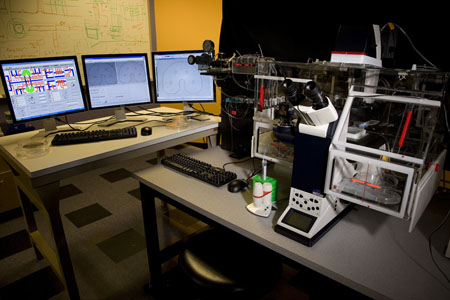
About ISBISB is a biological research facility located near the UW campus in Seattle, WA. Committed to the development of predictive, preventive medicine, ISB uses systems approaches to understand the biology and medicine. Baliga Lab The Baliga Group at ISB studies the gene regulatory network of Halobacteria salinarum, a salt-loving extremeophile. Using a systems approach, the group observes the effects of environmental changes on gene expression in Halo and map out the pathways that archea utilize to regulate their gene expression and adapt to their challenges to their new environment. The group then develops mathematical models of these regulatory networks in order to regulate to predict the affects of new changes to the cell's environment. They also development software such as Gaggle or cMonkey, in order to sort and analyze the massive amounts of data accumulated using a system's approach. In the future, these efforts will further the development of predictive, preventive medicine by allowing scientists and doctors to understand and manipulate such networks in humans that are diseased or malfunctioning.
The Baliga Group at ISB studies the gene regulatory network of Halobacteria salinarum, a salt-loving extremeophile. Using a systems approach, the group observes the effects of environmental changes on gene expression in Halo and map out the pathways that archea utilize to regulate their gene expression and adapt to their challenges to their new environment. The group then develops mathematical models of these regulatory networks in order to regulate to predict the affects of new changes to the cell's environment. They also development software such as Gaggle or cMonkey, in order to sort and analyze the massive amounts of data accumulated using a system's approach. In the future, these efforts will further the development of predictive, preventive medicine by allowing scientists and doctors to understand and manipulate such networks in humans that are diseased or malfunctioning. Another important goal of the Baliga Group is improving science education. The group works with schools throughout Washington to create models centered around Halobacterium to teach systems biology concepts to middle and high schoolers. |
|
Any opinions, findings, and conclusions or recommendations expressed in this material are those of the author(s) and do not necessarily reflect the views of the National Science Foundation. Institute for Systems Biology, 1441 North 34th Street, Seattle, WA 98103-8904 |
 It is located in the fascinating city of Fremont with a long and interesting history and many interesting shops and locations. The facility is right next to the Burke-Gilman trail a beautiful biking and jogging trail that goes through various locations such a the UW campus and the Gas Works park.
It is located in the fascinating city of Fremont with a long and interesting history and many interesting shops and locations. The facility is right next to the Burke-Gilman trail a beautiful biking and jogging trail that goes through various locations such a the UW campus and the Gas Works park.
 Using large scale technology and powerful computer algorithms, it reveals insights about how the building blocks of life work in the presence of others that cannot be revealed while studying them in isolation. ISB’s main medical goal is the development and advancement of predictive and preventive medicine.
Using large scale technology and powerful computer algorithms, it reveals insights about how the building blocks of life work in the presence of others that cannot be revealed while studying them in isolation. ISB’s main medical goal is the development and advancement of predictive and preventive medicine.